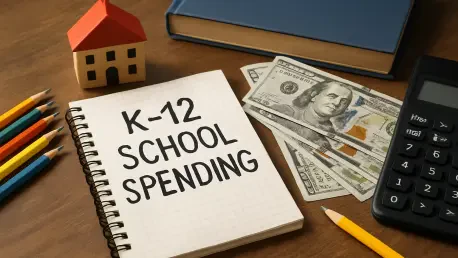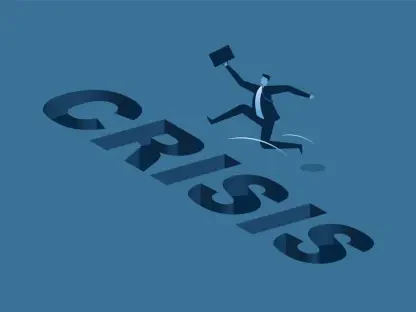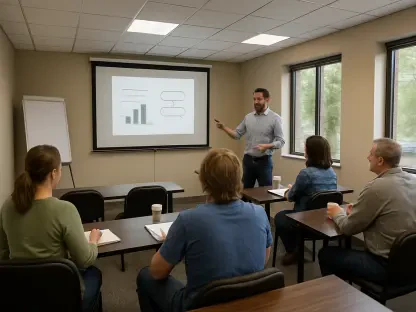In an era where public education funding in the United States is reaching unprecedented heights, the latest data reveals that annual K-12 school spending is on the brink of hitting a staggering $1 trillion, a milestone that underscores both remarkable growth and persistent systemic issues that continue to challenge the system. According to recent analyses, per-student spending has surged by over 35% in the last two decades, reflecting a national commitment to education that translated to $946.5 billion in 2023 alone. Yet, beneath this financial boom lie significant challenges that threaten to undermine the impact of these investments. Declining student enrollment, stagnant teacher compensation, ballooning employee benefit costs, and disappointing academic outcomes paint a complex picture of a system struggling to align resources with results. Even as federal relief funds from recent years provided a temporary boost, their expiration raises urgent questions about sustainability. This article delves into the intricate landscape of K-12 education funding, exploring key trends and structural hurdles that demand attention from policymakers and stakeholders alike. With the future of public education hanging in the balance, understanding these dynamics is essential to ensuring that increased spending translates into meaningful progress for students across the nation.
Unprecedented Funding Levels
The scale of investment in K-12 public education has reached historic proportions, with national spending recorded at $946.5 billion in 2023, equating to an average of $20,322 per student. This figure marks a substantial rise from previous decades, driven by a combination of state, local, and federal contributions. Notably, eight states now allocate over $25,000 per student, with New York leading the pack at nearly $37,000 annually. However, this growth is far from uniform, as disparities persist with states like Idaho spending significantly less. Such variations highlight the uneven distribution of resources and raise questions about equity in educational opportunities. While the numbers are impressive, they also reflect a reliance on temporary boosts, particularly from federal relief packages that have supported budgets in recent years. As these funds dwindle, the challenge lies in maintaining current levels of investment without compromising essential programs or widening existing gaps between high- and low-spending regions.
Beyond the headline figures, the sustainability of this funding trajectory remains a pressing concern for school districts nationwide. The infusion of nearly $190 billion in federal aid since 2020, aimed at mitigating the impacts of global disruptions, has played a critical role in propping up budgets during turbulent times. Yet, with this support now largely expired, administrators face the daunting task of balancing ambitious educational goals against tightening fiscal realities. Many districts risk being caught off guard if alternative revenue streams or cost-saving measures are not identified promptly. The stark reality is that while funding has soared to near-record levels, the long-term stability of these investments is uncertain, especially in regions already grappling with economic constraints. Policymakers must now navigate this delicate landscape, ensuring that the momentum of increased spending does not falter as external support diminishes, while also addressing the deeper structural issues that threaten to erode the benefits of these financial gains.
Misallocation of Resources
A deeper look into expenditure patterns reveals a troubling shift in spending priorities, with a growing portion of K-12 budgets being consumed by non-instructional costs rather than direct classroom investments. Employee benefits, including pensions and health insurance, have seen an alarming 81.1% increase per student over the past two decades, far outpacing the modest 7.7% rise in salary expenditures during the same period. This disproportionate growth in benefit costs, particularly in states like New Jersey where they exceed $7,900 per student, often stems from unfunded pension liabilities that burden state budgets. Such trends divert critical resources away from essential areas like instructional materials and teacher support, raising serious concerns about the long-term financial health of public education systems. The challenge lies in rebalancing these allocations to prioritize investments that directly impact student learning and development over administrative or legacy costs.
Compounding this issue is the broader implication of misaligned spending on the quality of education delivered to students. When funds are siphoned into benefits and other non-instructional areas, schools struggle to address immediate classroom needs, such as updated technology or smaller class sizes, which are vital for effective learning environments. This misallocation often leaves educators under-resourced, despite the overall increase in funding, and perpetuates a cycle where financial growth fails to translate into tangible improvements. In regions with particularly high benefit costs, the strain is even more pronounced, as local districts grapple with meeting pension obligations while trying to maintain competitive educational offerings. Addressing this imbalance requires a strategic overhaul of budget priorities, ensuring that the lion’s share of resources is directed toward initiatives that enhance academic outcomes rather than being absorbed by escalating ancillary expenses.
Staffing Disparities Amid Declining Enrollment
Another critical issue facing K-12 education is the mismatch between staffing levels and student enrollment trends, which poses significant fiscal challenges for public schools. Over the past two decades, staffing has increased by 15.1%, even as student numbers grew by just 4.1%. More strikingly, non-teaching staff—such as counselors, aides, and administrative personnel—now account for over half of all public school employees. This trend has persisted despite a notable decline of 1.18 million students since 2020, with states like California adding thousands of non-teaching positions while losing hundreds of thousands of students. Such disparities suggest a lack of alignment between resource allocation and actual demand, creating inefficiencies that could strain budgets further. With enrollment projected to drop an additional 5.3% by 2032, the current staffing model appears increasingly unsustainable, necessitating urgent adjustments to reflect demographic realities.
The implications of this staffing surplus extend beyond mere numbers, impacting the overall financial stability of school districts already facing economic uncertainty. Maintaining a workforce that outpaces student needs ties up funds that could be redirected to critical areas like teacher training or curriculum development. In many cases, the growth in non-teaching roles, while intended to provide additional support, has not demonstrably improved educational outcomes, raising questions about the effectiveness of such expansions. As enrollment continues to decline, particularly in urban centers, districts may face difficult decisions, including potential layoffs or school closures, to right-size their operations. Tackling this issue requires a thoughtful reevaluation of staffing priorities, ensuring that personnel levels are calibrated to serve current and projected student populations rather than adhering to outdated or inflated models of resource distribution.
Stagnation in Teacher Compensation
Despite the historic highs in K-12 funding, teacher salaries have not kept pace with inflation or the rising cost of living, creating a significant barrier to attracting and retaining quality educators. In real terms, average teacher pay has declined by 6.1% over the last two decades, with an especially sharp 5.6% drop occurring in the years following 2020 due to inflationary pressures and competing budgetary demands. This erosion is particularly evident in states like North Carolina, where declines have been among the steepest, threatening the profession’s appeal at a time when skilled educators are desperately needed to address learning gaps. While a handful of states have managed modest increases, the national trend remains discouraging, highlighting a disconnect between overall spending growth and the compensation provided to those on the front lines of education.
This stagnation in teacher pay carries broader consequences for the education system, as it risks undermining morale and exacerbating staffing shortages in an already challenging environment. When salaries fail to reflect the critical role teachers play, districts struggle to compete with other professions for top talent, particularly in high-need areas like STEM or special education. The impact is felt most acutely by students, who may face larger class sizes or less experienced instructors as a result of recruitment difficulties. Addressing this issue demands a targeted approach to budgeting, where teacher compensation is prioritized over less direct expenditures like administrative costs or facility upgrades. Without meaningful action to reverse this downward trend, the ability of public schools to deliver high-quality education will remain compromised, even as funding levels continue to climb.
Persistent Decline in Student Achievement
Perhaps the most alarming trend in K-12 education is the persistent decline in student academic performance, despite billions of dollars poured into the system. Data from the National Assessment of Educational Progress (NAEP) reveals a growing proportion of students failing to meet even basic proficiency standards in core subjects like math and reading. This downward trajectory, which began before the global disruptions of recent years, has only worsened, with scores continuing to drop through 2024. The disconnect between record funding and academic outcomes raises fundamental questions about how resources are being utilized and whether they are effectively addressing the needs of students. This trend is particularly concerning for policymakers who must reconcile the promise of increased investment with the reality of diminishing returns in the classroom.
Adding to the complexity, much of the federal relief funding intended to combat learning loss appears to have been misdirected, often spent on non-academic priorities rather than targeted interventions. Significant sums went toward infrastructure projects or facility upgrades, while critical areas like tutoring or remedial programs for struggling students—especially those from low-income backgrounds—received insufficient attention. This misstep has deepened existing achievement gaps, leaving many students further behind at a time when recovery is paramount. The evidence suggests that without a clear focus on academic support, additional funding alone will not reverse these declines. A shift in strategy is needed, emphasizing data-driven initiatives that directly address learning deficiencies and ensure that investments yield measurable improvements in student performance over time.
Charting a Path Forward
Reflecting on the state of K-12 education funding, it becomes evident that while spending nears an extraordinary $1 trillion annually, systemic inefficiencies have hindered the potential for transformative change. Ballooning benefit costs, disproportionate staffing levels, declining teacher pay, and worsening student outcomes have collectively exposed the limitations of simply increasing budgets without strategic oversight. These challenges, compounded by shrinking enrollment and the exhaustion of federal relief funds, have placed public schools at a critical juncture where tough decisions are inevitable. The data paints a sobering picture of a system rich in resources yet struggling to deliver on its core mission of educating the next generation effectively.
Looking ahead, the path to sustainable improvement hinges on targeted reforms that prioritize student success over ancillary expenditures. Policymakers should focus on restructuring budget allocations to curb the growth of non-instructional costs, particularly pension liabilities, freeing up funds for direct classroom investments. Realigning staffing models to match enrollment trends, enhancing teacher compensation to attract top talent, and directing resources toward proven academic interventions are essential steps to bridge the gap between spending and outcomes. As demographic shifts and economic pressures continue to shape the educational landscape, adopting a forward-thinking approach that emphasizes accountability and adaptability will be crucial. Only through such deliberate actions can the promise of near-trillion-dollar investments be realized, ensuring that public education fulfills its vital role in shaping future generations.








